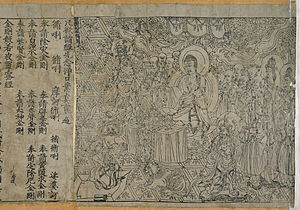പൗരാണികാനന്തര ചരിത്രം

പൗരാണികാനന്തര ചരിത്രം (പൂർവാധുനിക ചരിത്രം എന്നും വിളിക്കപ്പെടുന്നു) എന്നത് ലോകചരിത്രത്തിലെ ഒരു കാലഘട്ടത്തെ സൂചിപ്പിക്കാൻ ഉപയോഗിക്കുന്നു. മധ്യകാലം എന്ന് വിശേഷിപ്പിക്കുന്ന കാലഘട്ടവും ഏകദേശം ഇതേ കാലയളവാണ്. എഡി 500 മുതൽ 1450 വരെയാണ് സാമാന്യമായി ഈ കാലഘട്ടത്തിൽ ഉൾപ്പെടുന്നത്. നാഗരികതകളുടെ ഭൂമിശാസ്ത്രപരമായ വളർച്ചയും, ക്രിസ്തുമതം, ഇസ്ലാം, ബുദ്ധമതം എന്നിവയുടെ വികാസവും, നാഗരികതകൾ തമ്മിലുള്ള വ്യാപാരബന്ധങ്ങളുടെ വ്യാപനവും ഈ കാലഘട്ടത്തെ കുറിക്കുന്നു.[1][2]
ഏഷ്യയിൽ ഇസ്ലാമിന്റെ വികാസം പുതിയ സാമ്രാജ്യവും ഇസ്ലാമിന്റെ സുവർണകാലം എന്ന് വിളിക്കപ്പെടുന്ന കാലഘട്ടവും ഉണ്ടാക്കി. ഈ കാലത്ത് ഏഷ്യൻ, ആഫ്രിക്കൻ, യൂറോപ്യൻ രാജ്യങ്ങൾ തമ്മിൽ വ്യാപാരവും, മധ്യകാല ഇസ്ലാമിക ലോകത്ത് ശാസ്ത്ര പുരോഗതിയും നടന്നു. പൂർവേഷ്യ ചൈനസാമ്രാജ്യത്തിന്റെ സ്ഥാപനത്തിന് സാക്ഷിയായി. ചൈനാസാമ്രാജ്യം അഭിവൃദ്ധി പ്രാപിച്ച ഒരുപാട് രാജവംശങ്ങളെ സംഭാവന ചെയ്തു. കൊറിയ, ജപ്പാൻ,വിയറ്റ്നാം മുതലായ രാജ്യങ്ങളെ വളരെ സ്വാധീനിക്കുകയും ചെയ്തു, ബുദ്ധമതം, നിയോ കൺഫ്യുഷനിസം മുതലായ മതങ്ങൾ പ്രചരിച്ചു. ഈ കാലഘട്ടത്തിലാണ് വെടിമരുന്ന് ചൈനയിൽ കണ്ടുപിടിച്ചത്. മംഗോൾ സാമ്രാജ്യം യൂറോപ്പിനെയും ഏഷ്യയെയും യോജിപ്പിച്ചു, അങ്ങനെ ഈ വൻകരകൾ തമ്മിൽ സുരക്ഷിതമായ വ്യാപാരപാതകൾ തുറക്കപ്പെട്ടു. എ ഡി 500 ൽ 210 ദശലക്ഷം ആയിരുന്ന ലോകജനസംഖ്യ എ ഡി 1500 ആയപ്പൊളേക്കും ഇരട്ടിച്ച് 461 ദശലക്ഷത്തിലെത്തി.[3] ജനസംഖ്യ ഈ കാലഘട്ടത്തിൽ അനുസ്യൂതം വളർന്നുകൊണ്ടിരുന്നെങ്കിലും ജസ്റ്റീനിയൻ പ്ളേഗ്, മംഗോൾ അധിനിവേശം, ബ്ലാക്ക് ഡെത്ത് മുതലായ തിരിച്ചടികളും ജനസംഖ്യ നേരിട്ടിരുന്നു.[4]
അവലംബം
[തിരുത്തുക]- ↑ The Post‐Classical Era Archived 2014-10-31 at the Wayback Machine. by Joel Hermansen
- ↑ Stearns, Peter N. (2017). "Periodization in World History: Challenges and Opportunities". In R. Charles Weller (ed.). 21st-Century Narratives of World History: Global and Multidisciplinary Perspectives. Palgrave. ISBN 978-3-319-62077-0.
- ↑ Klein Goldewijk, Kees; Beusen, Arthur; Janssen, Peter (2010-03-22). "Long-term dynamic modeling of global population and built-up area in a spatially explicit way: HYDE 3.1". The Holocene. 20 (4): 565–573. doi:10.1177/0959683609356587. ISSN 0959-6836.
- ↑ Haub (1995): "The average annual rate of growth was actually lower from 1 A.D. to 1650 than the rate suggested above for the 8000 B.C. to 1 A.D. period. One reason for this abnormally slow growth was the Black Plague. This dreaded scourge was not limited to 14th century Europe. The epidemic may have begun about 542 A.D. in Western Asia, spreading from there. It is believed that half the Byzantine Empire was destroyed in the 6th century, a total of 100 million deaths."
Text is available under the CC BY-SA 4.0 license; additional terms may apply.
Images, videos and audio are available under their respective licenses.
